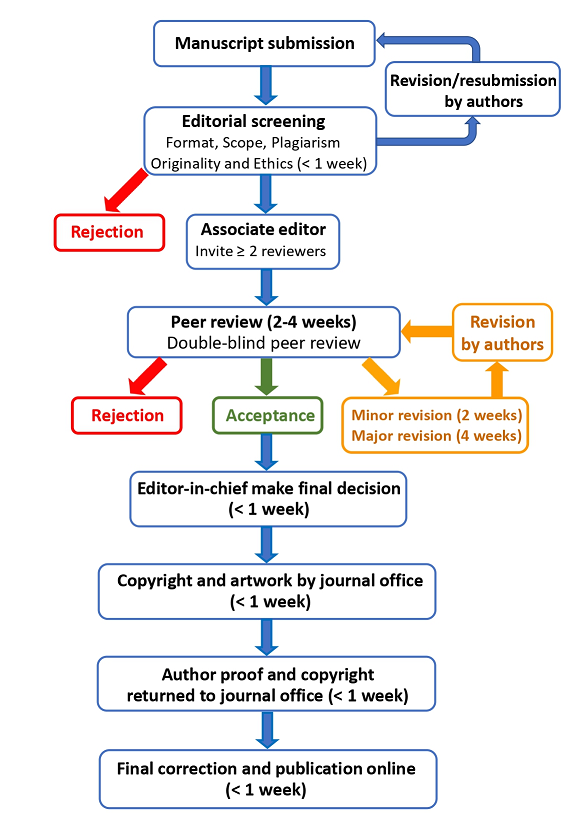Peer Review Process

Step 1: Submission
All submissions must be made online via the Digital Commons submission system (https://digital.car.chula.ac.th/clmjournal/). All submission items, including all text, Tables, Figures, conflict of interest disclosures, and any other required companion documents) should be uploaded through the Digital Commons submission system.
Step 2: Initial Screening (< 1 week)
The Editor-in-Chief and Editorial Office will assess manuscripts. If the manuscript is not of sufficient merit to reach priority for publication, does not meet ethical standards, the score of similarity index check using iThenticate service is more than 30%, or is not appropriate for the scope of Journal, then it may be rejected without reviewed. The editorial office will check the article formatting and citation styles that adhere to the stylistic and bibliographic requirements described in the journal’s author guidelines. If the required conditions are not achieved, the manuscript will be returned to the author for reformatting and resubmission. If the manuscript passes approval, it will undergo peer review process. This initial screening usually takes less than one week.
Step 3: Assign an Associate Editor (< 1 week)
The Editor-in-Chief assigns an Associate Editor to handle a double-blind peer review process. The associate editor will then send invitations to reviewers. Our journal is committed to assigning reviewers within one week.
Step 4: Invite Peer Reviewers (2-4 weeks)
At least 2 reviewers, who are appropriate independent experts recruited by associate editor. After agreeing to review, external peer reviewers typically have 2-4 weeks to submit their review.
The authors will be blinded to reviewers, who will be treated anonymously. The reviewers will have no connection with the authors and will preferably be from another country or at least a different institution. Additionally, the potential reviewers consider the invitation against their own scientific expertise, any potential conflicts of interest, and other relevant criteria. If these reviewers disagree on key issues, then further reviewers will be invited to deliver opinions until a consensus is reached.
Step 5: Evaluate the Reviews (2-4 weeks)
Before determining if the submitted manuscript is viable for publication, the associate editor takes into account all the returned comments and recommendations. The reviewers appraise the manuscript and advise the associate editor on whether the manuscript should be: a) accepted as is, or b) requested a minor revision, or c) requested a major revision, or d) rejected for publication.
The associate editor considers reviewer feedback and their own evaluation of the manuscript. Then make a recommendation to the Editor-in-Chief. In case of revision, the author is basically given 2 weeks (for minor revision) and 4 weeks (for major revision) to complete the manuscript. The major revised manuscript will undergo a second round of review by the same reviewers, who will evaluate whether the revisions adequately address their feedback. For minor revisions, the subsequent review process may not be necessary.
Step 6: Deliver Final Decisions (< 1 week)
Upon receipt of the revised manuscript, the Editor-in-Chief will review the revisions and will make a final decision on whether the revised manuscript is acceptable for publication, or not, ahead of final screening. This process will take about one week. The Editor-in-Chief has the final authority on all editorial decisions. The average time from submission to the first decision will be 4 weeks, and from acceptance to publishing will be 3-4 weeks.
Step 7: Preparation of Final Version (2 weeks)
Accepted manuscripts are then copyedited and formatted according to the Journal’s house style and the galley proof in the form of a PDF file are delivered by the managing editor to the corresponding author for final approval. This process generally takes within 2 weeks.
Step 8: Proofreading and Online Publication (< 1 week)
Following the corresponding author’s submission of the galley proof, the Editor-in-Chief checks the author confirmed proof and approves it for publication. The manuscript will be assigned for the Digital Object Identifier (DOI) number, issue, volume, and year. The current issue will be uploaded on the journal website (http://www.clmjournal.org).









